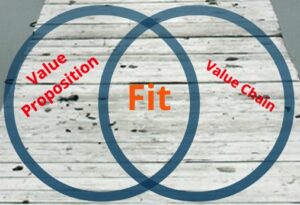Strategy is, and should be simple. It consists of the 3 dimensions shown here: Value Proposition, Value Chain and how well they fit or are  aligned.
aligned.
FORTUNE magazine, well known for its business insights, printed an article in 1999 called “Why CEOs Fail”, highlighting an important fact: 70% of CEO failures were caused by poor execution against the business strategy.
As you may know, Forbes magazine printed an update to that article on March 22, 2012, reaffirming this unfortunate statistic is still true today. Forbes listed examples of expedited CEO departures from companies such as BP, Hewlett-Packard, Bank of New York Mellon and Yahoo. These companies had strong visions, business strategies and plans. So these failures were not the result of poor business strategy. The challenge we face in today’s businesses continues to be in execution.
What causes organizations to miss the bar in execution, and how can current CEOs drive improvement in execution? To answer this keyquestion, let's begin with defining "strategy".
What is “business strategy”? It's not the huge, complicated binder on the shelf. It is more specific than being "the best". If we ask 50 CEOs we’ll probably get 50 different answers. As shown in the graphic above, Strategy is 3-dimensional:
- The Value Proposition for the customer
- The Value Chain of activities the company performs
- The Fit - the effective alignment of 1 and 2 throughout the business
The purpose of strategy is to return capital to the owners or shareholders of the business.
The Value Proposition is based on the reason your customers buy from you vs. your competition. It’s the promise you make to your customers: it’s what differentiates your product or service from the rest.
The Value Chain includes all of the various functional and individual activities and tasks your people perform every day as they do their jobs. It includes work processes as well as your functional and organization practices; these reflect the company culture and values, an important factor that influences how work gets done.
When Value Chain isn’t well aligned with the Value Proposition, Fit is not optimized and this misalignment creates obstacles to getting work done. Organizational obstacles often coincide with conflicting objectives and create frustration or conflict between people and groups, ineffective decision-making. When the value chain is not effectively aligned with the value proposition, people need to work around standard procedures to get things done. Lost time and extra activities insidiously add extra cost into the business. Indicators such as interpersonal conflicts, work-arounds and teamwork issues are generally visible when alignment throughout your Value Chain needs improvement. Importantly, the organization under-performs. Can you think of some ways this may be occurring in your business?
Improving strategy execution begins with mapping the value-added activities, which comprise your Value Chain, and assessing the alignment of your organization’s Value Chain to the Value Proposition. Alignment for execution requires a tight fit between 5 value chain components with your value proposition:
1. Strategic Understanding
How well does each member of your workforce understand who your competitors are, how they differ, and what it is that your business delivers that differentiates you from the competition? Can each employee relate his/her role, skills and daily performance to delivery of your company's unique, differentiating value? Is this a regular topic of discussion at work?
2. Leadership
Do your organization's executives and managers have high credibility with the workforce? How effectively do they lead and support people through necessary change? How often and how clearly do they communicate in different and interesting ways, the company strategy and the value proposition? What is the compelling story they tell that engages your workforce in achieving the strategy?
3. Balanced Metrics
What are the metrics used to measure and monitor your organization's performance? Do they guide people in prioritizing their tasks each day? Is there a blend of financial (lagging) indicators and non-financial (leading) indicators? Do people use the leading indicators to spot problems or obstacles early and implement solutions? Can employees access information on their own performance? On the performance of their team? How often is performance on metrics reviewed and discussed? What level of involvement do employees have in anticipating and solving problems that impact strategic performance?
4. Activities and Structure
Has your organization evaluated it's processes, procedures, policies, budget, and organization structure, to identify ways to improve alignment with the strategy? Doing this effectively helps to remove obstacles to getting work done, and helps to standardize and automate the tasks required to deliver your promised, unique differentiating value to the customer. Frequently, independent initiatives such as Lean, IT, or training have different purposes and objectives that can conflict and impede strategic performance. This is often the case when an organization implements generic Best Practices. Have your functional initiatives been aligned to fit the strategy of your company?
5. Human Capital
One glance at a Standard & Poors chart tells a story all leaders need to know: the value of intangible and tangible assets has actually made a complete reversal in recent decades. Where in the past investors looked primarily at a company's tangible assets such as bricks and mortar, machinery and equipment, to determine the value of a business -- investors now look almost exclusively at the intangible assets such as intellectual capital, leadership credibility, brand, strategic relationships, execution capability and human capital. People are now the primary value. Is your organization effectively investing in and leveraging the value of its people? Is training aligned with the strategy? Are new hires selected based on criteria that include ability to add strategic value? Are employees placed in positions using their preferred skills and offering growth and autonomy? Is the culture one of compliance in a command-control environment, or one of commitment in an environment of inclusion?
Experience has shown that these are the areas and the questions leaders need to be asking and addressing in order to build capacity and readiness to executive on the strategy. On a final note, it's also important, as people focus on improvement and efficiency, to have "market discipline" in choosing the one thing your company can excel, whether it's customization of products and services, leading edge products and services, or best value i.e. low price, hassle-free, good selection. Market Discipline means you differentiate in one core area, and perform well in the others. Choose your value proposition, assess it periodically in light of technological and competitive changes in the market place and change it when needed. We've all learned that change is the constant that will characterize business success into the future.
Please share your company's practices as they relate to these questions. What obstacles are you facing in strategy execution?
Latest posts by Rosanna Nadeau, PCLEC (see all)
- Is Quality Being Lost In Today’s Quest For Efficient Execution? - August 31, 2023
- What is HR’s Strategic Role? - August 24, 2023
- Agility: The Ability to Zig and Zag - August 23, 2023













